|
|
Highflyer

|
|
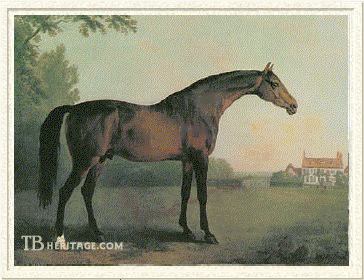 |
|
|
Magnificent Highflyer was the hero of his time, first an unbeatable racehorse, and then the greatest stallion of his era.
He was bred by Sir Charles Bunbury, the fifth Baronet, who, upon the death of his father, Sir William Bunbury in 1764, had inherited the title and family estates at Mildenhall and Great Barton Hall in the eastern county of Suffolk. The breeding center of England had begun to shift from the northern counties of Yorkshire and Durham, south, to the area around Newmarket. The Godolphin Arabian had stood in neighboring Cambridgeshire, and Highflyer's sire, Herod, spent his entire career at Neather Hall Stud, near Bury St. Edmunds just east of Newmarket. It was at Great Barton, just northeast of Bury St. Edmunds, that Highflyer was foaled in 1774.
Bunbury was a long-standing member of Parliament, but it was his role as a member, and later Steward, of the Jockey Club which made him noteworthy. He was also a notorious gambler, a worse hypochondriac and his wife had left him amid much scandal. He had previously raced the popular little grey horse Gimcrack (1760), and three years after Highflyer was foaled, bred another one for the ages, Diomed (ch.c. 1777). As a three-year-old in Bunbury's colors, Diomed had won the first running of the Derby Stakes at Epsom, a race for which the name was determined by a coin toss between the Lords Derby and Bunbury. Had luck smiled another way, the classic would have been known as "the Bunbury Stakes." Diomed stood at stud with some success at Great Barton, but when exported to Virginia as an aged stallion, reinvented the racing breed in the United States.
Highflyer's dam was Rachel (1763), a daughter of Blank bred by the Duke of Ancaster at Grimsthorpe. Rachel's dam, often referred to as "sister to South," was a daughter of Regulus. Since both Blank and Regulus were sons of the Godolphin Arabian, Rachel was therefore inbred 2x3 to that great foundation sire. Rachel's first foal had been the good horse Mark Anthony (b.c. 1767) by Spectator, who lives on in pedigrees as the sire of the dam of Paynator.
Highflyer was sold as yearling to Lord (Viscount) Bolingbroke, who, it was said, named Rachel's bay colt after the Highflyer walnut trees that grew in the paddock where the horse was foaled at Great Barton. Even so, some controversy arose, almost 20 years after the fact, about when Highflyer was named. There was reason to believe that he was still unnamed for his first two races, and started as "Lord Bolingbroke's colt by Herod." The debate was critical, since the Herod colt in question lost those first two races at Newmarket, which would refute Highflyer's record as undefeated. The case was decided after hearing from Mr. Robson, whose father, Thomas Robson of Newmarket, had trained Highflyer, and whose brother had rubbed him. Robson swore that "Highflyer was never beat, nor paid forfeit!" After the investigation, it was decided that the Herod colt in question was Lord Bolingbroke's homebred out of the mare Marotte, and not Highflyer at all, so his perfect record remained intact. The General Stud Book made a point of noting this discrepancy, and chose to find on the side of the undefeated Highflyer.
Highflyer ran with Bolingbroke's turf pseudonym, "Mr. Compton," listed as owner. His racing career coincided with an important shift in racing at the time, since only a few years earlier, the trend had been to wait until a horse was five-years-old before racing. Highflyer first started as a three-year-old over two miles, although later he competed in more traditional heat racing over four miles.
His first start was on October 2 at Newmarket, in a two mile event against three-year-olds, in which he defeated Justice, Bordeaux, and Sweet Marjoram, the first four finishers all sired by Herod. He reappeared the next year at the Second Spring Meeting at Newmarket against his own age, returned to Newmarket in July to again defeat four-year-olds, and again on October 1. He then won an open stakes, scaring off most of the competition, and ended the season defeating Dictator (by Matchem) in a match race at Newmarket.
Turning five in 1779, he opened the year with two more victories before Lord Bolingbroke was made an offer he couldn't refuse. Feeling some financial pinch, possibly due to gambling debts, he sold his prize to Richard Tattersall (1724-1795), known as "Old Tatt", who had admired the colt from the time of his birth. The price was 2,500 pounds.
Tattersall was from Yorkshire, and in his early years had served as Master of Horse for the Duke of Kingston. He became deeply involved in the art of horse-selling, and became astute at handling the dispersal of bloodstock from various noble estates, including the famous dispersal of the Duke of Cumberland's horses, a sale which included Eclipse, Marske, and Herod. Tattersall established a famous bloodstock sales empire at Hyde Park Corner, and later moved the rapidly expanding enterprise to Knightsbridge.
Highflyer's first effort for his new owner was a walk over at Nottingham, followed by another walk over at York in the Great Subscription Stakes. He tallied a second Great Subscription Stakes, then moved on to Lichfield, where he won the King's Purse in three mile heats. This was his fourteenth and final race. Tattersall decided it was time to move Highflyer's talents to the stud paddock.
Highflyer in the Stud
Highflyer was retired to Tattersall's farm, Red Barns, between Bury St. Edmunds and Ely. Here he was put to the very serious work of making Tattersall rich. His initial stud fee was 15 guineas and over time, was raised up to a high of 50 guineas, but the scope of the marketing plan was much bigger than that. Highflyer was put to so many mares that his owner later faced criticism for breeding the horse to death. There was apparently no limit on the number of mares bred to him. Further, given the nick that was clearly being demonstrated between the great Eclipse and Highflyer's sire Herod, Tattersall's scheme involved buying up every daughter of Eclipse he could find, breeding them to Highflyer, and selling them in foal. And he encouraged his friends and associates to "Send me your Eclipse mares, and you shall have the best racehorses in England as a result."
The ensuing income from sales of seasons and mares in foal made Tattersall a very rich man indeed. It was estimated that he received at least 15,000 pounds a year in income from Highflyer's seasons. With this new found wealth, he built a new mansion at Red Barns, and named it Highflyer Hall.
|
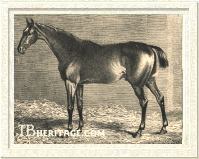
Sir Peter (Teazle) 
Skyscraper with lopped ears

Diamond
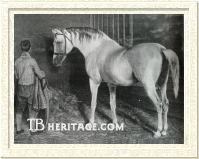
Delpini
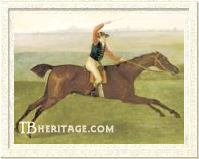
Traveller
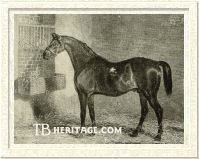
St. George
| | As a stallion, Highflyer exceeded all expectations and has been judged by some to be the most successful sire of the eighteenth century, exceeding even his contemporary, Eclipse. He followed his own sire, Herod (the Leading Sire from 1777 to 1784) as the Leading Sire in Great Britain and Ireland for 15 years, from 1785 to 1796, and again in 1798. He sired 469 winners, including the remarkable feat of getting the winners of the Derby three years out of four, with NOBLE (won in 1786), SIR PETER TEAZLE (1787), and SKYSCRAPER (1789). His other classic winners included OMPHALE (St. Leger in 1781), SPADILLE (St. Leger in 1787), YOUNG FLORA (St. Leger in 1788) and VOLANTE (Oaks in 1792).
SIR PETER TEAZLE (br.c. 1784 out of Papillon by Snap) was by far his important offspring, and an individual portrait of him is available on this site. A great racehorse, he became, like his sire and grandsire before him, one of the leading sires of the English turf, leading as sire of winners from 1799 to 1802, and from 1804 to 1809. Just as his grandsire King Herod became known to the ages as simply "Herod," Sir Peter Teazle is more often shown in pedigrees as "Sir Peter" than with his full name. Sir Peter sired five Derby winners, Sir Harry, Archduke, Walton, Paris, and Pan; four winners of the St. Leger, Ambrosio, Fyldener, Paulina, and Petronius; and two Oaks winners, Hermione and Parisot. He also sired Agonistes, Stamford, Gouty, Sir Solomon, Robin Redbreast, Haphazard, Williamson's Ditto, Sir Paul, Houghton Lass, Pipylina, Virgin, Desdemona, and numerous other important sires and dams.
DELPINI (gr.c. 1781) was by Highflyer out of Countess by Blank, and so inbred 3x2 to Blank, also sire of Highflyer's own dam. Delpini sired the Oaks winners Scotia and Theophania as well as St. Leger winner Symmetry, besides the stallions Evander, Timothy, Seymour, and several important mares including Zara.
DIAMOND (br.c. 1792, from a daughter of Matchem's) was a good distance horse, winner of the Jockey Stakes at Newmarket in 1796, and a dead-heat for second place with Brother to Overton in York's Great Produce Stakes, over four miles, in which the Derby winner Spread Eagle (to whom Diamond ran 4th in the Derby) was unplaced. In the next two years he won Newcastle's King's Plate, the King's Plate at Newmarket First October, an 800 guineas sweestakes at Newcastle, the Oxford Cup over 4 miles, the King's Plate at Nottingham, a 1,000 guineas match against Shuttle, the King's Plate at Newmarket First Spring, and the Jockey Club Plate at Newmarket. In 1798 he was beaten by Hambletonian in a famous 3,000 guineas match at Newmarket, immortalized by several artists. He was sent to stud in America.
TRAVELLER (b.c. 1785, out of Sister to Prosperine) was a good runner at ages 3 and 4 under the tutelege of trainer John Hutchinson of Shipton, Yorkshire (breeder of Beningbrough and Hambletonian), winning two mile races at Stockton and Northallerton, and a race in three mile heats at Northallerton at age three, at at age four winning the four mile Stand Plate and the Great Subscription Purse at York before being sold the the Prince of Wales. For the Prince, he won a 500 guineas match against Grey Diomed at Newmarket, and another match the following spring at Newmarket against the Eclipse son Meteor. He lost form after that, gaining a few compromises in matches, but otherwise generally failing to place.
Highflyer's son ROCKINGHAM (b.c. 1781) was out of Purity, a sister to the famous Pumpkin, by Matchem. Rockingham's most important offspring was his daughter, Castianira, imported to America and dam of the legendary runner and sire Sir Archy (by imported Diomed). Highflyer's other important male offspring included ESCAPE (sire of the second dam of Irish Birdcatcher and Faugh-a-Ballagh), PHARAMOND, SLOPE, SPADILLE, WALNUT, SOUR-CROUT, and ST. GEORGE.
|
| Included among Highflyer's daughters was a mare that had possibly more influence than any other of his progeny, even Sir Peter. That was his daughter, PRUNELLA (b.f. 1788), bred by the Duke of Grafton out of Promise by Snap, her next dam the famous Julia by Blank (also making Prunella inbred to Blank). Prunella produced the Derby winner Waxy Pope (by Waxy), as well as the Oaks winner Pelisse (by Whiskey). She is the most important conduit of the #1 Family, largely through her daughter Penelope (by Trumpator).
|
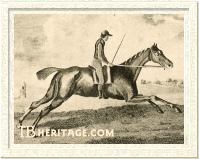
Eliza
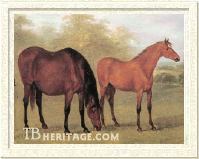
Huncamunca

Maria | | Of Highflyer's daughters on the turf, ELIZA (b.f., 1791, bred by O'Kelly out of the Eclipse daughter Augusta, and sold to "Father of the Turf" Christopher Wilson, was one of the best. As a three year old she won the Town Plate at Newmarket, beating seven other fillies, and ran second in the Oaks and in a 100 guineas sweep stakes at York, which was won by Beningbrough. At age four she won a Produce Stakes at York commemorated by the sketch of her running (shown here), the four mile Richmond Cup, and one other races, placing third to Hambletonian in the four mile Doncaster Cup and third to Beningbrough in the Doncaster Stakes. At age five she won the King's Plate and the Great Subscription Purse at York, and the Doncaster Stakes at Doncaster, and ran second in Newmarket's Craven Stakes, placing third in several other good races.
In the stud she produced three daughters that bred on, one of them, by Shuttle, producing a Doncaster Cup winner in the grey Consul. Bred to her old racing nemesis Beningbrough, Eliza became the dam of Doncaster winner Scud, who later got two Derby winners, Sam and Sailor, and an Oaks winner, Shoveler.
Another of Highflyer's daughters, GREY HIGHFLYER (gr.f. 1782) out of Monimia by Matchem, was the dam of the important sire Hambletonian (by King Fergus). Another daughter was an unnamed mare referred to as "Eagle's Dam" (b.f. 1785) who produced the Derby winners Spread Eagle (by Volunteer) and Didelot (by Trumpator), besides the sire Eagle (by Volunteer), imported to America.
Highflyer's daughter HUNCAMUNCA (Br.f. 1787, out of Cypher, became the dam of Derby and St. Leger winner Champion, and was grandam, tail-female of Oaks winners Maid of Orleans and Charlotte, and third dam of Derby winner Mameluke. Another daughter, MARIA (b.f. 1791, from Maria by Telemachus) became the dam of Ascot Gold Cup winner Champignon.
|
Highflyer also sired the dams of Meteora, Coelia, N.M.B.O., Dick Andrews, Orville, Paulowitz, Cervantes, Sancho, Oscar, and Bedford.
Tattersall's idea of a Highflyer nick with Eclipse mares resulted in Skyscraper, Lambinos, St. George, Volante, and Oberon. His daughters did even better with sons and grandsons of Eclipse (Hambletonian, Dick Andrews, Orville, Waxy Pope), and their lines became inextricably intwined, forming the foundation for the modern Thoroughbred.
Highflyer was a richly shaded bay, the only white on him was his left hind pastern. He was light-limbed, well-balanced individual showing tremendous quality. He was still in the mold of the "old style" Thoroughbred, with a distinctly Arabian profile and top line, a small and elegant head with a large eye, a finely arched neck, short back, long and level croup and high set tail. He had great length and depth of barrel, tremendously muscled quarters and a well-laid back shoulder.
From reports, when Highflyer began to fail physically, he did so rapidly, and the great horse died on October 18, 1793 at the age of 19. One source says he was "worn out in the service of venery before his time," although his sire, Herod, had only lived a few years longer, dying in 1780 at the age of 22. Highflyer was laid to final rest in his paddock near the mansion his success had caused to be built.
While it doesn't seem that Tattersall was a man of cloying sentiment, he did provide Highflyer with an appropriate epitaph. "Here lieth the perfect and beautiful symmetry of the much lamented Highflyer, by whom and his wonderful offspring the celebrated Tattersall acquired a noble fortune, but was not ashamed to acknowledge it."
---Anne Peters and Patricia Erigero
|
|
|
|

